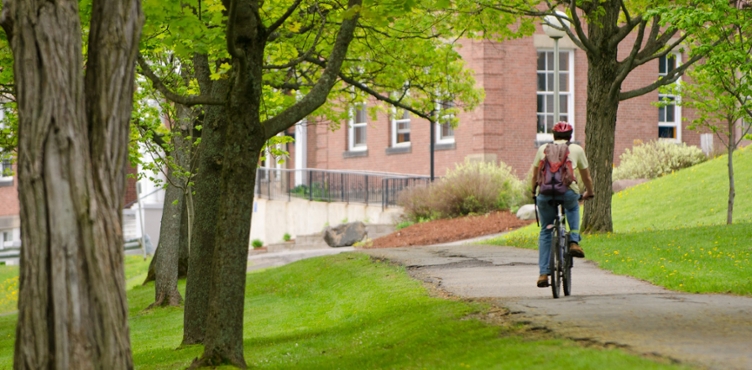Wrapping up

Calculate your carbon footprint
Your carbon footprint is a measure of how many tonnes of greenhouses gases you are responsible for emitting in terms of carbon dioxide equivalents – this means your carbon footprint considers all greenhouses (including carbon dioxide, methane, and nitrous oxide), but tells you about your result in terms of tonnes of carbon dioxide only.
Take some time to explore the below carbon footprint calculators:
If you're a UNB student completing this module for coursework, be sure to complete the reflection section as part of your requirements.
Focus on: Eco-anxiety
Increasing numbers of people worldwide are experiencing negative mental health impacts due to climate change. This is a normal response to the crisis we face.
In addition to eco-anxiety (anxiety focused on the effects of climate change and other ecological issues), some people are experiencing eco-grief (grief for the losses being experienced due to climate change) and eco-paralysis (feeling overwhelmed and helpless in the face of the climate crisis).
If you are experiencing one or more of these feelings, it is important to remember that you are not alone. Mental health experts suggest taking the following steps:
- Remember that both good and bad things happen in this world. Step back from “doom-scrolling” and focus on stories about climate hope and solutions.
- Talk about your feelings with your friends and people you trust.
- Make time for self-care, including exercise, mindfulness, meditation, and similar activities.
- Spend time in nature. The mental and physical health benefits of time outdoors are increasingly well-researched.
- Take time to engage in creative expression, such as visual art, drama, poetry, or writing, etc.
- Take time to reflect on your place in the world, your values, and your particular strengths that you can bring to take action.
- Build your social connections by joining organizations, groups, and communities of interest with similar values to your own. Take part in events and help build community with like-minded people focused on positive solutions.
- Create positive spaces to talk about the many impacts of climate change with others.
- Take individual and collective action on climate change – from small changes in your habits to getting involved in politics – based on your strengths and interests.
- Remember that it is important to also take breaks and time to recharge yourself. Let yourself take time without feeling guilty.
Learn more:
- Exploring climate change and mental health
- How climate change is re-shaping the way Gen Z works
- Inner Development Goals: Skills for sustainable development
*External video - no transcript available
Conclusion
In this module, we looked at what climate change is and how the mechanism behind climate change, the greenhouse effect, works. We took a brief look at the role of the IPCC (Intergovernmental Panel on Climate Change) and how the Sustainable Development Goals (SDGs) connect with climate change and its effects.
We paused to quickly check your understanding, and then surveyed some of the positive actions being taken toward climate action at the international, national, provincial, university, and personal levels, along with some of the obstacles faced at each level of action.
You took a few minutes to use a simple carbon footprint calculator and then took some time to reflect on how you feel about climate change, your carbon footprint results, how climate change is or might be affecting your community in the future, and what positive actions you or your community can take to help. Finally, we wrapped up with a quick look at eco-anxiety, a growing mental health issue that has deep ties to climate change.
Call to action
Based on what you have learned in this module, brainstorm five possible actions you could take related to climate change and choose one to complete.
(Ex. take steps to limit your carbon use, attend a meeting or join a climate justice organization, use art to express your eco-anxiety, join a eco-anxiety support group (ex. Facebook groups, art groups, etc.), join an environmental society).
Resources
Learn more
Academic resources
- Clayton, S. (2020). Climate anxiety: Psychological responses to climate change. Journal of Anxiety Disorders, 74, 102263.
- Fawzy, S., Osman, A. I., Doran, J., & Rooney, D. W. (2020). Strategies for mitigation of climate change: a review. Environmental Chemistry Letters, 1-26.
- Wynes, S., & Nicholas, K. A. (2017). The climate mitigation gap: education and government recommendations miss the most effective individual actions. Environmental Research Letters, 12(7), 074024.
Videos
- Climate change - We are the problem & the solution
- What is the greenhouse effect?
- Introduction to climate justice
- Can you fix climate change?
- Do we need nuclear energy to stop climate change?
- Climate change 101 with Bill Nye
- Act now on climate change – Greta Thunberg
- Climate change - Why the urgency?
- Young people are the solution to climate change
- What is climate adaptation?
- How can we adapt to climate change?
Webinars and tools
This work is licensed under a Creative Commons Attribution-NonCommercial 4.0 International License.

